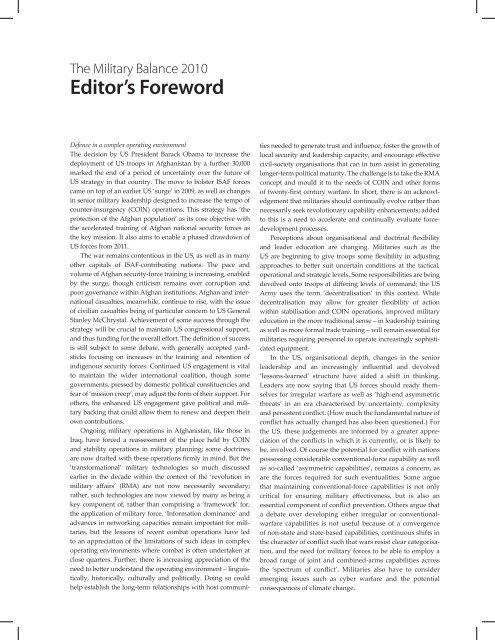Create successful ePaper yourself
Turn your PDF publications into a flip-book with our unique Google optimized e-Paper software.
The Military Balance 2010<br />
Editor’s <strong>Foreword</strong><br />
Defence in a complex operating environment<br />
The decision by US President Barack Obama to increase the<br />
deployment of US troops in Afghanistan by a further 30,000<br />
marked the end of a period of uncertainty over the future of<br />
US strategy in that country. The move to bolster ISAF forces<br />
came on top of an earlier US ‘surge’ in 2009, as well as changes<br />
in senior military leadership designed to increase the tempo of<br />
counter-insurgency (COIN) operations. This strategy has ‘the<br />
protection of the Afghan population’ as its core objective with<br />
the accelerated training of Afghan national security forces as<br />
the key mission. It also aims to enable a phased drawdown of<br />
US forces from 2011.<br />
The war remains contentious in the US, as well as in many<br />
other capitals of ISAF-contributing nations. The pace and<br />
volume of Afghan security-force training is increasing, enabled<br />
by the surge, though criticism remains over corruption and<br />
poor governance within Afghan institutions. Afghan and international<br />
casualties, meanwhile, continue to rise, with the issue<br />
of civilian casualties being of particular concern to US General<br />
Stanley McChrystal. Achievement of some success through the<br />
strategy will be crucial to maintain US congressional support,<br />
and thus funding for the overall effort. The definition of success<br />
is still subject to some debate, with generally accepted yardsticks<br />
focusing on increases in the training and retention of<br />
indigenous security forces. Continued US engagement is vital<br />
to maintain the wider international coalition, though some<br />
governments, pressed by domestic political constituencies and<br />
fear of ‘mission creep’, may adjust the form of their support. For<br />
others, the enhanced US engagement gave political and military<br />
backing that could allow them to renew and deepen their<br />
own contributions.<br />
Ongoing military operations in Afghanistan, like those in<br />
Iraq, have forced a reassessment of the place held by COIN<br />
and stability operations in military planning; some doctrines<br />
are now drafted with these operations firmly in mind. But the<br />
‘transformational’ military technologies so much discussed<br />
earlier in the decade within the context of the ‘revolution in<br />
military affairs’ (RMA) are not now necessarily secondary;<br />
rather, such technologies are now viewed by many as being a<br />
key component of, rather than comprising a ‘framework’ for,<br />
the application of military force. ‘Information dominance’ and<br />
advances in networking capacities remain important for militaries,<br />
but the lessons of recent combat operations have led<br />
to an appreciation of the limitations of such ideas in complex<br />
operating environments where combat is often undertaken at<br />
close quarters. Further, there is increasing appreciation of the<br />
need to be�er understand the operating environment – linguistically,<br />
historically, culturally and politically. Doing so could<br />
help establish the long-term relationships with host communi-<br />
ties needed to generate trust and influence, foster the growth of<br />
local security and leadership capacity, and encourage effective<br />
civil-society organisations that can in turn assist in generating<br />
longer-term political maturity. The challenge is to take the RMA<br />
concept and mould it to the needs of COIN and other forms<br />
of twenty-first century warfare. In short, there is an acknowledgement<br />
that militaries should continually evolve rather than<br />
necessarily seek revolutionary capability enhancements; added<br />
to this is a need to accelerate and continually evaluate forcedevelopment<br />
processes.<br />
Perceptions about organisational and doctrinal flexibility<br />
and leader education are changing. Militaries such as the<br />
US are beginning to give troops some flexibility in adjusting<br />
approaches to be�er suit uncertain conditions at the tactical,<br />
operational and strategic levels. Some responsibilities are being<br />
devolved onto troops at differing levels of command; the US<br />
Army uses the term ‘decentralisation’ in this context. While<br />
decentralisation may allow for greater flexibility of action<br />
within stabilisation and COIN operations, improved military<br />
education in the more traditional sense – in leadership training<br />
as well as more formal trade training – will remain essential for<br />
militaries requiring personnel to operate increasingly sophisticated<br />
equipment.<br />
In the US, organisational depth, changes in the senior<br />
leadership and an increasingly influential and devolved<br />
‘lessons-learned’ structure have aided a shift in thinking.<br />
Leaders are now saying that US forces should ready themselves<br />
for irregular warfare as well as ‘high-end asymmetric<br />
threats’ in an era characterised by uncertainty, complexity<br />
and persistent conflict. (How much the fundamental nature of<br />
conflict has actually changed has also been questioned.) For<br />
the US, these judgements are informed by a greater appreciation<br />
of the conflicts in which it is currently, or is likely to<br />
be, involved. Of course the potential for conflict with nations<br />
possessing considerable conventional-force capability as well<br />
as so-called ‘asymmetric capabilities’, remains a concern, as<br />
are the forces required for such eventualities. Some argue<br />
that maintaining conventional-force capabilities is not only<br />
critical for ensuring military effectiveness, but is also an<br />
essential component of conflict prevention. Others argue that<br />
a debate over developing either irregular or conventionalwarfare<br />
capabilities is not useful because of a convergence<br />
of non-state and state-based capabilities, continuous shifts in<br />
the character of conflict such that wars resist clear categorisation,<br />
and the need for military forces to be able to employ a<br />
broad range of joint and combined-arms capabilities across<br />
the ‘spectrum of conflict’. Militaries also have to consider<br />
emerging issues such as cyber warfare and the potential<br />
consequences of climate change.


